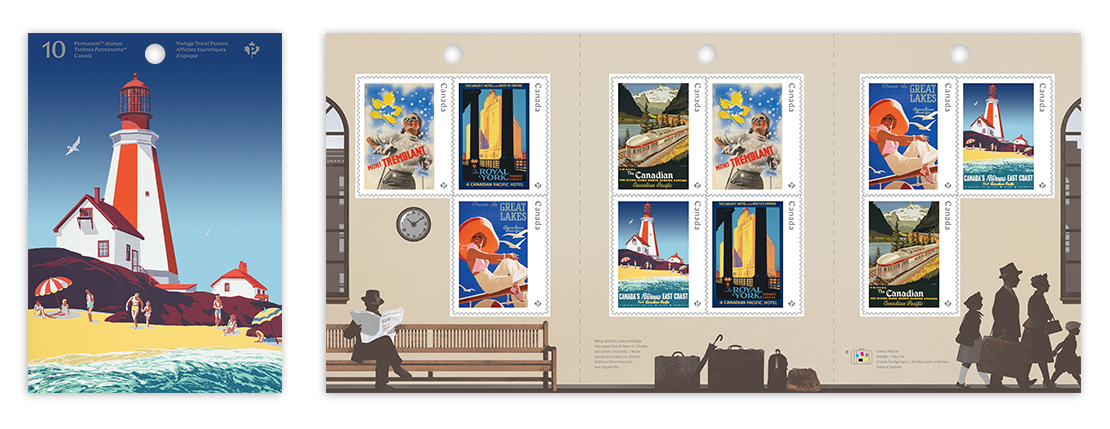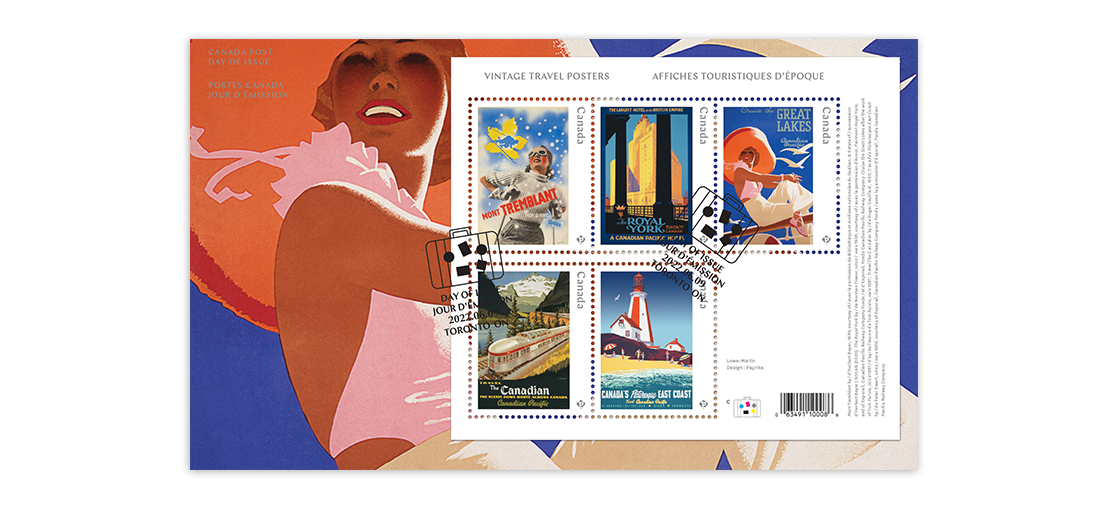By the early 20th century, Canada’s popularity as a tourist destination was beginning to surge. Companies such as the Canadian Pacific Railway, Canada Steamship Lines and the Canadian National Railway commissioned talented illustrators and designers to create eye-catching posters that beckoned visitors to explore the country’s natural beauty and urban attractions. Promising world-class adventure, spectacular scenery and luxury, the ads targeted globe-trotting tourists and Canadians alike. Canada Post’s latest stamps celebrate some of this outstanding work, which is notable for its distinctive and elegant styles.
Golden age of tourism marketing
Canada Post just released five stamps from a golden age of commercial art and tourism marketing in Canada. Its Vintage Travel Posters collection features alluring ads from the 1930s to 1950s. The five posters chosen for the issue evoke nostalgia for an era of glamorous travel and the spirit of exploration.

Travel The Canadian (1955), by Montréal-born artist Roger Couillard, captures the luxury and spectacular scenery that awaited passengers aboard Canadian Pacific’s famous transcontinental train. Pictured winding its way through the Rocky Mountains, the Canadian offered panoramic views from its innovative, glass-domed observation cars.

Cruise the Great Lakes (circa 1937), created after the work of British designer Tom Purvis, captures the breezy glamour of pleasure cruising on the world’s largest group of freshwater lakes. Companies such as Canadian Pacific offered multi-day outings as a way for vacationers to relax and visit various destinations along their route.

The Royal York (circa 1935) was just one of many travel posters designed by Norman Fraser, who was considered Canadian Pacific’s most prolific poster artist. Viewed from behind the columns at Union Station, the stately, 28-storey Canadian Pacific hotel (now the Fairmont Royal York) was the tallest building in Toronto and the largest hotel in the British Empire when its doors opened in June 1929.

Mont Tremblant (1939) promoted the excitement of skiing at Quebec’s new resort, built by American explorer and entrepreneur Joseph Bondurant Ryan just two years after he first climbed the peak. The poster was designed by Austrian-born artist Herbert Bayer, who taught at Germany’s prestigious Bauhaus school of design before working as a painter and graphic designer in the United States.

Canada’s Picturesque East Coast (circa 1950) was designed by Saskatchewan-born Peter Ewart, who worked as a poster artist for Canadian Pacific and was also a painter and sculptor. Aimed at drawing tourists to the east coast, it highlighted three seaside destinations: Saint Andrews (also known as St. Andrews by-the-Sea), New Brunswick; Digby, Nova Scotia; and Yarmouth, Nova Scotia. Featured on the poster is the original Cape Forchu Lighthouse, which was in service for more than 120 years.

The front and inside covers of the three-panel booklet feature the pictorial images from two of the posters featured on the stamps: Canada’s Picturesque East Coast and Travel The Canadian. The inside background of the booklet displays a silhouetted image of travellers at a train station by illustrator Gérard DuBois.

The front of the OFDC, meanwhile, presents a close-up of the traveller on the Cruise the Great Lakes poster.
Canada Post has a long history of celebrating Canada’s landscapes, wildlife, people and their achievements as part of its iconic national stamp program.
Stamps celebrate golden age of commercial illustration
Available now